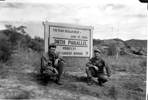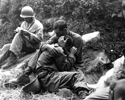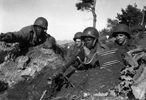Korean War





The Korean War (25 June 1950 - 27 July 1953) was a war between the Republic of Korea (South Korea), supported by the United Nations, and the Democratic People's Republic of Korea (North Korea), at one time supported by the People's Republic of China and the Soviet Union. It was primarily the result of the political division of Korea by an agreement of the victorious Allies at the conclusion of the Pacific War at the end of World War II. The Korean Peninsula was ruled by the Empire of Japan from 1910 until the end of World War II. Following the surrender of the Empire of Japan in September 1945, American administrators divided the peninsula along the 38th parallel, with U.S. military forces occupying the southern half and Soviet military forces occupying the northern half.
The failure to hold free elections throughout the Korean Peninsula in 1948 deepened the division between the two sides; the North established a communist government, while the South established a right-wing government. The 38th parallel increasingly became a political border between the two Korean states. Although reunification negotiations continued in the months preceding the war, tension intensified. Cross-border skirmishes and raids at the 38th Parallel persisted. The situation escalated into open warfare when North Korean forces invaded South Korea on 25 June 1950. In 1950, the Soviet Union boycotted the United Nations Security Council. In the absence of a veto from the Soviet Union, the United States and other countries passed a Security Council resolution authorizing military intervention in Korea.
The U.S. provided 88% of the 341,000 international soldiers which aided South Korean forces, with twenty other countries of the United Nations offering assistance. Suffering severe casualties within the first two months, the defenders were pushed back to the Pusan perimeter. A rapid U.N. counter-offensive then drove the North Koreans past the 38th Parallel and almost to the Yalu River, when the People's Republic of China (PRC) entered the war on the side of North Korea. Chinese intervention forced the Southern-allied forces to retreat behind the 38th Parallel. While not directly committing forces to the conflict, the Soviet Union provided material aid to both the North Korean and Chinese armies. The fighting ended on 27 July 1953, when the armistice agreement was signed. The agreement restored the border between the Koreas near the 38th Parallel and created the Korean Demilitarized Zone (DMZ), a 2.5-mile (4.0 km)-wide fortified buffer zone between the two Korean nations. Minor incidents still continue today.
From a military science perspective, the Korean War combined strategies and tactics of World War I and World War II: it began with a mobile campaign of swift infantry attacks followed by air bombing raids, but became a static trench war by July 1951...more
Additional information websites and articles:
https://en.wikipedia.org/wiki/Division_of_Korea
https://www.koreanwar.org/
https://www.trumanlibrary.org/whistlestop/study_collections/koreanwar/index.php
The Korean War: An Overview
What We Learned From the Korean War
Carpet-Bombing Falsehoods About a War That's Little Understood
